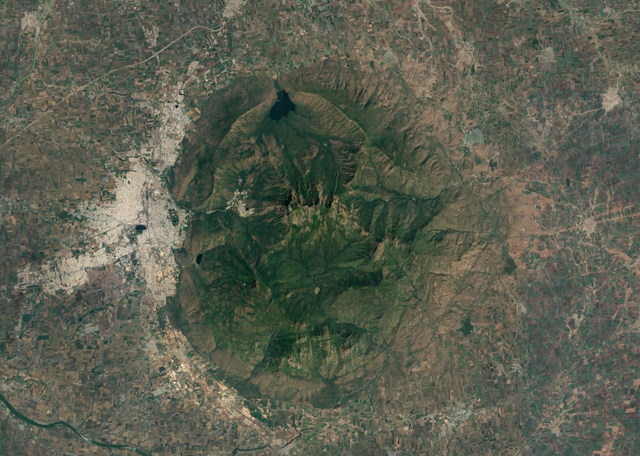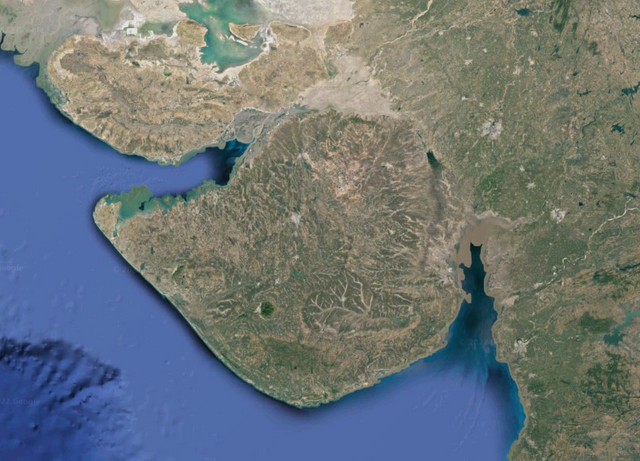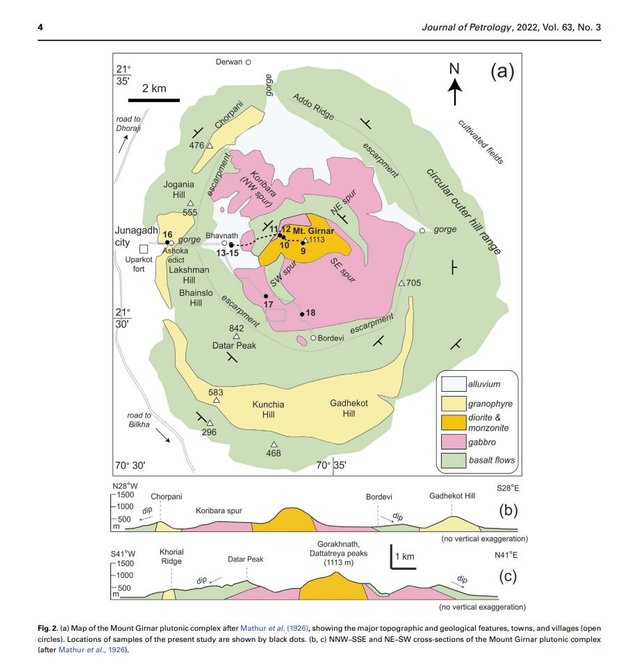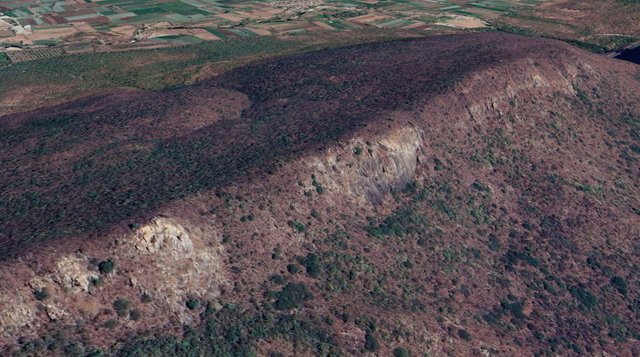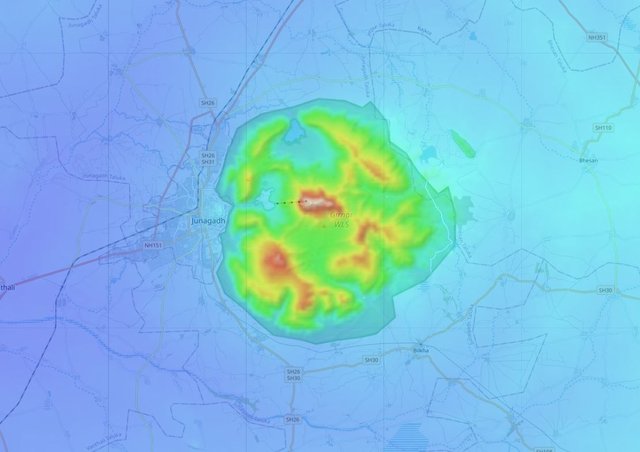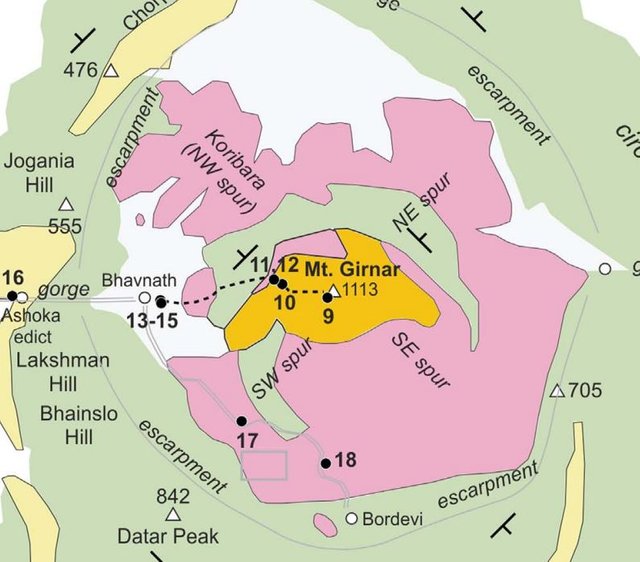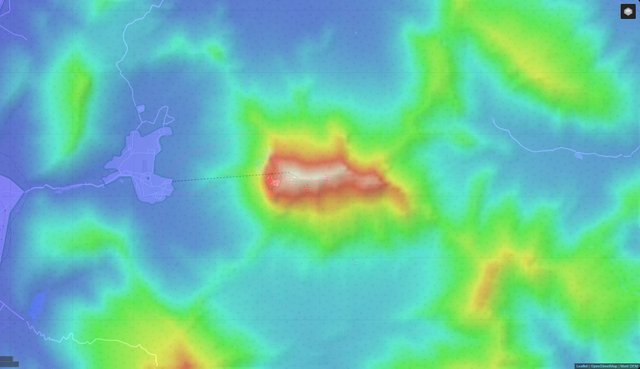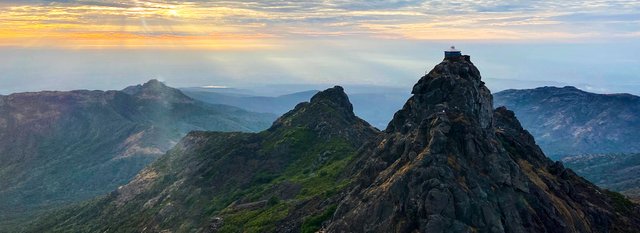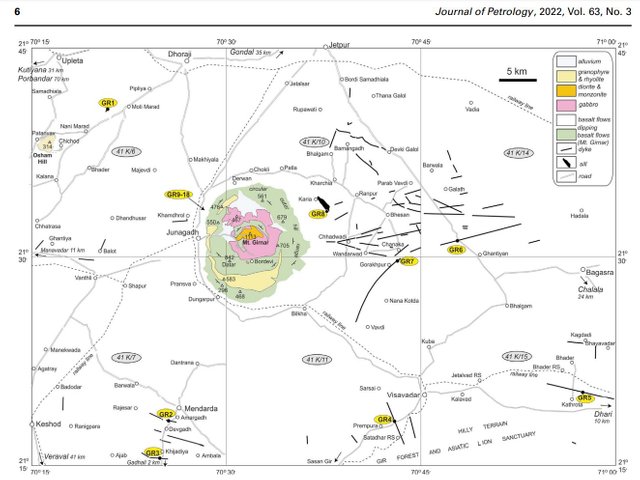Mount Girnar: The Catalyst
Introduction
Positioned in the midst of the Deccan Traps, Mount Girnar rises out of the plains of Kathiawar. Considered to be an intrusion formed around the Cretaceous-Paleogene boundary, the formation is unlike any other on Earth.

Figure 1: View of Mount Girnar from Bhavnath in Junagadh city of Gujarat, India
What Is In a Name?
The formation is known by many names.
By Jains it is known as Mount Neminath, where Lord Neminatha is said to have obtained nirvana. It is also believed to be the location where the next twenty-four tirthankaras will obtain nirvana.
Girnar comes from the root sanskrit words of gir, meaning "addressing; invoking; invocation, praise, song; a mountain", and nar, meaning "a man; husband; hero; the primordial Man; a lion-hearted man."
It is also known as Girinagar, giri meaning "mountain; hill" and nagar meaning "city; town."
Additionally the mountain is known as Revatak Parvata. Revata means "a boar; a bamboo cane; a whirlwind" and parvata means "a mountain, hill; a rock; an artificial mountain or heap; the number 'seven', a tree, a kind of vegetable, a cloud (mountain-like)."
Anciently it was known as Raivatagiri and Ujjayantagiri, where raivata means "brilliant, rich, wealthy, plentiful, splendid, beautiful," and ujjayanta refers to a temple/building.
Its first names were Kailashgiri and Svarnagiri. Kailasa refers to a type of temple, and is associated with a mountain in Tibet, and it means "crystal." Kailasa is also the name of the temple carved into a mountain at the Ellora Caves in Maharashtra, India. Svarna means "gold."

Figure 2: Kailasa Temple, Ellora Caves, India
Additional names attributed to Mount Girnar have been Girinarayana, Giriraj, Urjayat, Gomanta, Raivatari, Vastrapatha, Lingakara, Kanchana, Grimunga, Girinayara, Pushpagiri, Highland of St. John, Girnal, Karnal, Killa-e-Girnar, Devagiri, and more. For additional information on its many names, see Girinagar: Junagadh and Mount Girnar - One of the Most Ancient and Sacred Sites of India
And yet, it is also known as Girnar Hill. Standing at 3,672 feet at the highest point of this five-peaked mountain, when we compare it to the many other options of places to study geologically, it does not stand first by any historical metric of comparing geological features on Earth.
Mount Everest, by comparison, is 29,032 feet tall--nearly eight times the elevation of Mount Girnar.
For another comparison, Mount Everest is also known by Tibetans as Chomolungma, meaning "Mother Goddess of the World," and by Nepalese as Sagarmatha, "Goddess of the Sky." Where Girnar's list of names is nonexhaustive, this appears to be the full extent of alternative names for the tallest mountain in the world.
If a rose by any other name would smell as sweet, would a mountain by many other names indicate its importance over lesser named geological features?
Then, there is the fact that it sits alone in the plains of the Deccan Traps. With a 9 mile radius, it pales in comparison to the vast expanse of mountain chains like the Andes, which run 4,300 miles (7,000 kilometers) along the entire western stretch of South America with an average elevation in the range of 13,000 feet. The Rockies, the Alps, the Himalayas. These are mountains.
As described by Cucciniello et al.1, as of 2022:
"most of the studies relating to the plutonic complex and the silicic ring dyke are dated, whereas the circum-Girnar mafic intrusions...have been practically unstudied."
Standard metrics for ascertaining the significance of a mountain are all based on sheer size. Mountains can be arranged by their prominence--their elevation above the local terrain--or by their elevation above sea level. Mount Everest sits atop both of these lists and Mount Girnar does not fit in to this method of analysis. As a result, it pales in comparison to other mountains when analyzed by basic metrics.
While the mountain has received very little attention from the geological community, it has been ascribed with a long list of honorary titles. The reverence and love for Girnar has brought it to be the home to over 800 Hindu and Jain Temples.
But its unique geological nature has not gone entirely unnoticed.
In "Magmatic Differentiation in Mount Girnar,"2 by Mathur et al. from The Journal of Geology in 1926, they explain:
"The Girnar Hills form an imposing and characteristic land mass in the plains of Kathiawar. Considerable importance attaches to them from a religious and archaeological point of view, and the shrines on the top of the hill are visited by a large number of pilgrims every year. Geologically, they are no less important, yet so far little information exists about the interesting varieties of rocks they contain, or the structure of the hill ranges."
Here, Mathur et al. compare the importance of the geological structures of Mount Girnar to its religious importance, calling the geology of Mount Girnar "no less important."
The Geology of Mount Girnar
Mount Girnar's position in the heart of the Deccan Traps makes it a curious anomaly. The Deccan Traps are a large igneous province considered to be the result of a wide-spread eruption ~66Ma (million years ago). Notably, this coincides with the formation of the Chicxulub crater and the K-Pg boundary layer. They are a solidified flood basalt that is over 2,000 meters thick and 500,000 square kilometers.
As described by Mathur et al.:
"The quaquaversal dip in the surrounding basalt and the topographic features are possibly suggestive of a volcano, but there is little doubt that the rocks constitute a plutonic intrusion in the form of a laccolith, with a large number of differentiated types, which is probably unique in being the first of its kind studied in India."
Figure 3: Google Earth depicting Mount Girnar with surrounding basalt having a quaquaversal (directed outward from a common center towards all points of the compass) dip in its elevations.
In 1926, Mathur et al.2 considered Girnar to have intruded during "late Cretaceous, or early Eocene;" 66 - 55 Ma.
It has been established to have begun its formation process near the time of the K-Pg Boundary formation. Given a date of 65.3 ± 1.3 Ma in 1973 3, it is considered to belong to the Deccan Traps.
Based on whole rock K/Ar ratios, Girnar has been dated with large error bars to 63.6-56.2 Ma4.
The geology of Saurashtra, India has two differing features from the bulk of the Deccan Traps1:
- Numerous plutonic complexes dominated by gabbros and granophyres with diorite and monzonite important to Mount Girnar, and
- A wide range of rock types.

Figure 4: Saurashtra Region map
Figure 5: Mount Girnar is seen as the "eye of the bird" of Saurashtra.
As shown by Mathur et al.2,where the map was updated by Cucciniello et al.1, Girnar is highly complex in its differentiation. Sections of the mountain are composed of specific materials and void of the materials of other sections.
Separately, the intrusion was found to have segments of basalt, granophyre, olivine-gabbro, and diorite/monzonite:
Figure 6: Cucciniello et al. updated map of Mathur et al.
Magmatic differentiation is the process by which chemically different igneous rocks, such as basalt and granite, can form from the same initial magma.
On Girnar, the central mountain has peaks which run west to east, composed generally of diorite and monzonite.
The mountain can be separated into four geological components2:
- The circular outer ranges of hills,
- The central mountain,
- Radial ridges joining the central mountain to the outer hills; and
- Low plains occupying the intervening area.
The circular outer range of hills is, generally speaking, deeply escarped on the inner faces with gentler outer slopes. It is composed of granophyre, which is restricted to the outer hills, intruded through basalt.
Figure 7: Steeply escarped granophyre intrusions with gentler slopes on outer faces.
These form a ring that is most pronounced in the South and diminishes in the East and Northeast directions of the mountain, "but its continuity underground can be traced by veins too small to be shown on the map." 2
Figure 8: Topographic map of Mount Girnar
This ring lies in a large hexagonal basaltic border to the mountain, as is especially apparent from the mountain's physical appearance shown above in Figure 3. This first hexagon of basalt has a second, smaller hexagonal slab of gabbro and olivine-gabbro--partly covered by alluvium and intrusions--as is visible in Figure 6.
Similar to the ring of granophyre surrounding the mountain within the larger hexagonal basalt, the second hexagon of gabbro has a ring within it of basalt:
Figure 9: Zoom in on the second hexagon overlaid with alluvium and a basalt ring.
All of which is generally centered on the inner mountain of Girnar which is composed of diorite, monzonite, and biotite1,2. The biotite is especially restricted to the periphery of the central mountain and the junction with the surrounding olivine-gabbro.
The radial ridges projecting outward from the central mountain to the surrounding ring of dikes are principally composed of olivine-gabbro, except at the junctions with the central mountain where biotite is prevalent2. Their structure can be seen in Figure 3, and the topography:
Figure 10: A zoomed in topographical map of Mount Girnar showing the four ridges branching out from the central mountain to the surrounding circular dikes.
They dissect the region between the central mountain and outer ring into numerous ravines where plains of basalt on their outer margins and gabbro nearer the mountain, at times overlaid with deposits of alluvium from flowing streams, are enclosed.
As a result of the rich geological nature of Mount Girnar, it has been considered a unique opportunity to study magmatic differentiation. As stated by Mathur et al.2:
"From the description of the rock types and their close relationship in the field...., it is clear that this unique assemblage can only be regarded as one petrological unit derived from a common magma."
"The separation of a magma into two immiscible phases in the liquid condition has been regarded as one of the possible causes of differentiation. ...It is possible that the conditions which may bring about the separation of two liquid phases in a silicate melt did not exist in this reservoir."
"The facts of the case appear to be in better accord with the scheme of crystallization differentiation suggested by Bowen."
In short, the process discussed by Bowen is one in which volatiles play an important part in the separation of the magma. As Mathur et al. state:
"It is probable that in most granite batholiths the volatiles are distributed more or less evenly throughout the mass, whereas the actual concentration at any one place is not sufficiently high to effect the dissociation and separation of the alkali magma by the process contemplated [by Bowen]."
Evidence strongly suggests the separation process to have occurred, thus, due to the presence of volatiles and conditions capable of separating magma intrusions by crystallizations of different materials at different stages from a single source magma.
Further discussed by Cucciniello et al.1, there are what appear to be radially arranged, with respect to the plutonic complex of Mount Girnar, intrusions of dikes and sills, which are referred to as circum-Girnar intrusions:
Figure 12: Cucciniello et al. map of dykes and mafic intrusions especially prevalent east of Mount Girnar's plutonic complex.
Their study shows that some of the intrusions assimilated crustal material. The central mass has negligible assimilation of crustal material in the genesis of the most evolved materials of the mountain, but the surrounding dykes and sill, as well as the granophyre ring, all demonstrate degrees of assimilation of crust. Thus, it has been suggested that the central region had significantly thinner ancient crust than the surroundings.
Notably, they further conclude the granophyre ring to be unrelated structurally to the plutonic complex of the mountain, though this seems unlikely. This stems from both their distance away from the center, as well as the genetics of the rocks being so varied.
Ancient Dwarka
While the mountain is heavily covered with temples, as well as 9,999 stairs to the highest peak, and positioned in ancient lands, the first evidence of civilization at the mountain is only from 150 CE. The Junagadh rock inscription of Rudradaman has been dated to far more recent times than the mountain may otherwise warrant. Was it unnoticeable historically?
Or did it not even exist yet at all?
Evidence strongly suggests that Mount Girnar emerged in a vortex of energy due to a weapon attack on Ancient Dwarka; that the whole of the Deccan Traps were caused by this weapon. Indeed, that the whole Earth fractured apart and a global flood ensued.
And as a result of the process, Mount Girnar was emitted from the center of the Earth in a whirlwind of energy.
Today, the mountain is circumambulated yearly during the Lili Parikrama:

Figure 13: Girnar Parikrama Route Map.
Due to the vortex of energy in the formation of the mountain, there are distinct characteristics of Sacred Geometry in the energy flows creating Mount Girnar.
The presence of the hexagonal sheets of basalt and olivine-gabbro discussed above further supports the vortices involved in the formation of the mountain. Indeed, Dattatreya Peak is imprinted with the process:
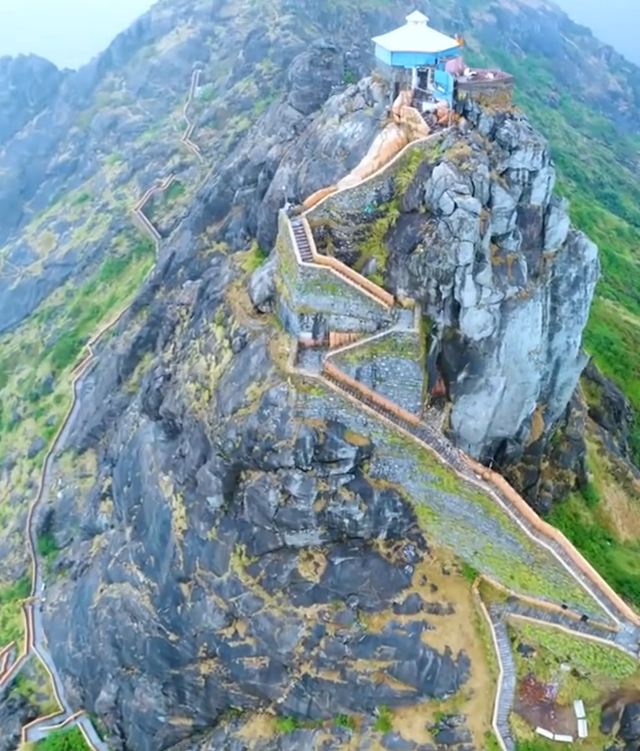
Figure 14: Dattatreya peak in a spiral formation.
Conclusion
Truly, this mountain is from heaven.
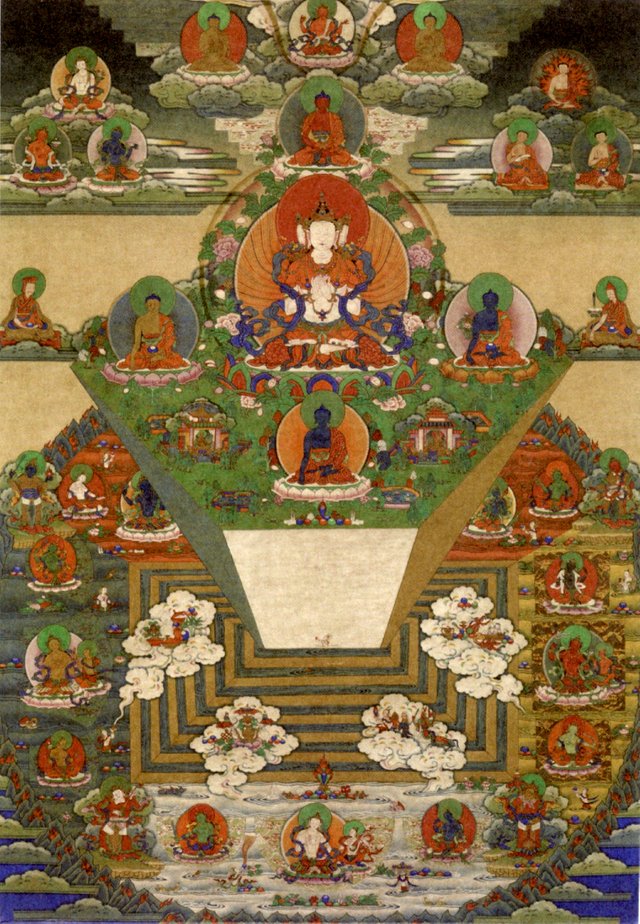
Figure 15: Bhutanese thangka of Mount Meru and the Buddhist universe
Additional links:
Dwarka: The Lost City of Krishna
The Geopolitical Impact of the Discovery of Ancient Dwarka
Ancient Dwarka: Tales in the Land
Ancient Dwarka: The Chicxulub Connection
References:
- "Mantle and Crustal Contributions to the Mount Girnar Alkaline Plutonic Complex and the Circum-Girnar Mafic-Silicic Intrusions of Saurashtra, Northwestern Deccan Traps," Cucciniello et al., Journal of Petrology, 2022, Vol. 63, No. 3, 1–30
- "Magmatic Differentiation in Mount Girnar," Mathur et al., The Journal of Geology, Volume XXXIV, No.4, 1926.
- Kaneoka, I. & Haramura, H. (1973). K/Ar ages of successive lava flows from the Deccan Traps, India. Earth and Planetary Science Letters 18, 229–236.
- Paul et al. (1977). Geochemical and petrogenetic study of the Girnar igneous complex, Deccan volcanic province, India. Geological Society of American Bulletin 88, 227–234.
